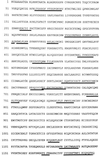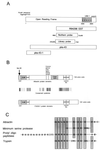Attractin (DPPT-L), a member of the CUB family of cell adhesion and guidance proteins, is secreted by activated human T lymphocytes and modulates immune cell interactions
- PMID: 9736737
- PMCID: PMC21643
- DOI: 10.1073/pnas.95.19.11336
Attractin (DPPT-L), a member of the CUB family of cell adhesion and guidance proteins, is secreted by activated human T lymphocytes and modulates immune cell interactions
Abstract
Attractin is a normal human serum glycoprotein of 175 kDa that is rapidly expressed on activated T cells and released extracellularly after 48-72 hr. We have cloned attractin and find that, as in its natural serum form, it mediates the spreading of monocytes that become the focus for the clustering of nonproliferating T lymphocytes. There are two mRNA species with hematopoietic tissue-specific expression that code for a 134-kDa protein with a putative serine protease catalytic serine, four EGF-like motifs, a CUB domain, a C type lectin domain, and a domain homologous with the ligand-binding region of the common gamma cytokine chain. Except for the latter two domains, the overall structure shares high homology with the Caenorhabditis elegans F33C8.1 protein, suggesting that attractin has evolved new domains and functions in parallel with the development of cell-mediated immunity.
Figures







References
-
- Shimizu Y, Shaw S. FASEB J. 1991;5:2292–2299. - PubMed
-
- Gilat D, Cahalon L, Hershkoviz R, Lider O. Immunol Today. 1996;17:16–20. - PubMed
-
- Hauzenberger D, Klominek J, Bergstrom S E, Sundqvist K G. Crit Rev Immunol. 1995;15:285–316. - PubMed
-
- Masuyama J, Berman J S, Cruikshank W W, Morimoto C, Center D M. J Immunol. 1992;148:1367–1374. - PubMed
-
- Brezinschek R I, Lipsky P E, Galea P, Vita R, Oppenheimer-Marks N. J Immunol. 1995;154:3062–3077. - PubMed
Publication types
MeSH terms
Substances
Associated data
- Actions
Grants and funding
LinkOut - more resources
Full Text Sources
Other Literature Sources
Molecular Biology Databases

